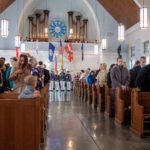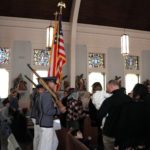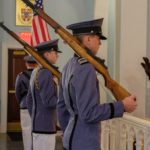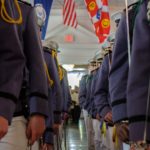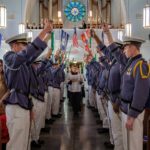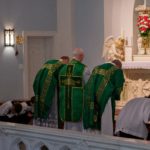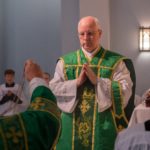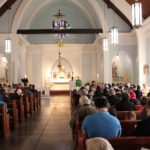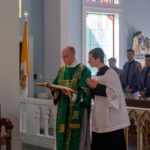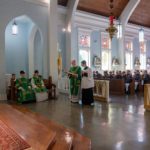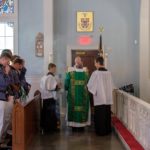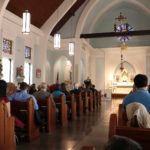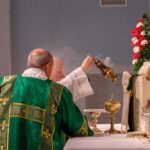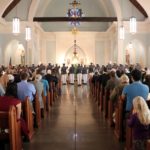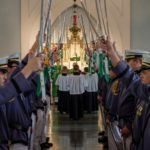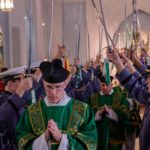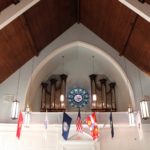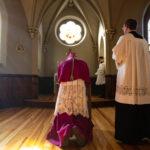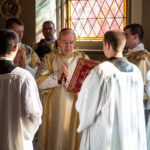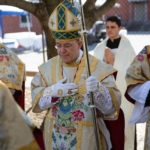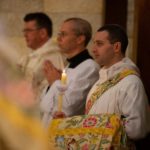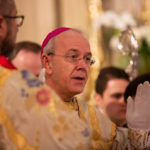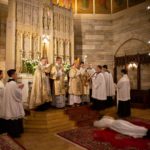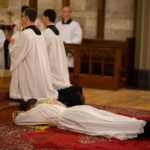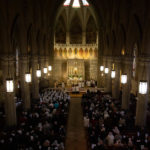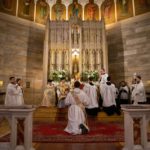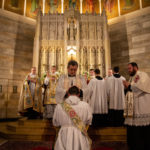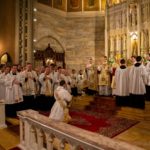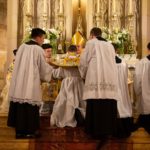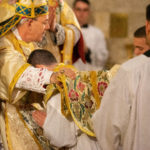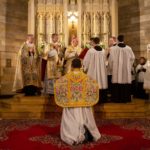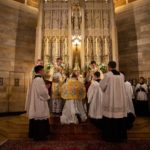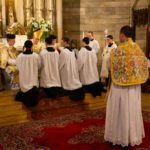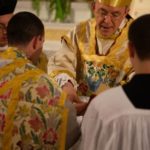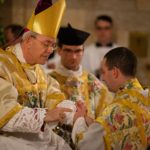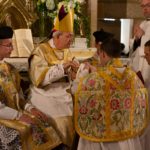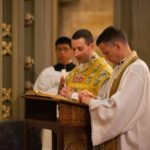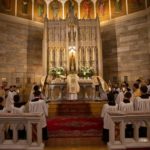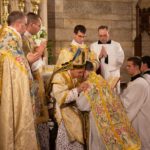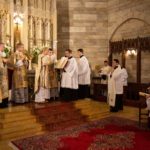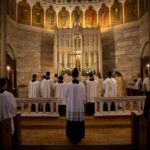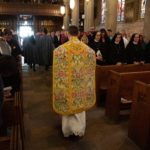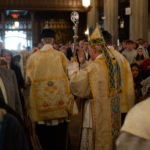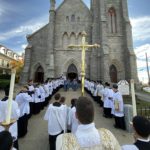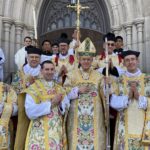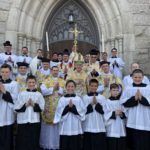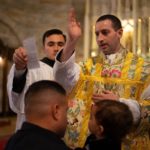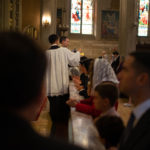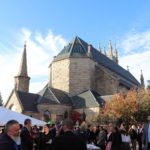Getting to Heaven and Home Plate

Catholicism and…baseball? What do the two have to do with each other? This past June, they were combined into a five-day camp headed up by Mr. Ryan O’Connor and his group from Highlight Catholic Ministries, based in Denver, Colorado. The Catholic baseball camp was designed for boys ranging from first to eighth grade, and was serious both about teaching the Catholic Faith and about teaching the fundamentals and virtuous habits of baseball.
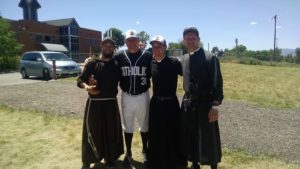
The Priestly Fraternity of St. Peter, represented by former professional baseball player and FSSP Baltimore assistant pastor Fr. Michael J. Cunningham along with seminarians Sam Florance and Joe Duffy, had a hand not only in the layout of the camp and in teaching the Catholic Faith, but also in coaching the boys in the many different skills of the game. The schedule included drills and instruction in hitting, infielding and outfielding, organized games, and contests that tested such skills as throwing accurately, fielding grounders and hitting home runs. Each day opened and closed with prayer and included talks and team prayer with Our Lord in the Blessed Sacrament.

When it comes to a Catholic sports camp, one might ask if, aside from the time in prayer, there is any real connection between the baseball skills the campers learn and their Catholic Faith. The answer is a most definitive yes: baseball offers a training ground for the soul as well as the body. For those who have the courage to try baseball, or any sport, and perform before friends, family and strangers, they put themselves at a definite risk of failure, injury and humiliation, all of which are opportunities to grow in patience and humility. Additionally, if we have the courage to risk failure, to get up when we fail and to learn from it, improvement and wisdom will follow. On the other hand, sports also give us a chance to win, succeed and be honored, and to learn the humility, gratitude and other virtues that, for the Christian athlete, must accompany success. Many other virtues come into play on the baseball diamond as well, players learning how to balance such emotions as anger and competitiveness with kindness and good sportsmanship.

Learning the virtues associated with the challenges, successes and failures of a game equips young people with the skills and experience they will need to navigate the twists, turns, losses and victories of life. Through a Catholic baseball camp, our youngsters can learn not only how to get to home plate, but how to get to Heaven, and how to perform with grace, no matter how many curve balls life throws at them. +
Photos provided by Frassati Sports.
December 4, 2019
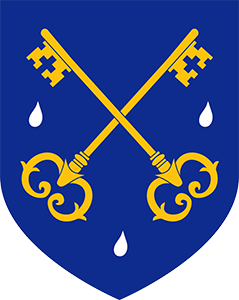
Let’s Support the Seminarians on Giving Tuesday!
Today is Giving Tuesday! Will you help us raise $60,000 for Our Lady of Guadalupe Seminary?
December 3, 2019

Happy Thanksgiving!
The Priestly Fraternity of St. Peter wishes a happy Thanksgiving to you and your families! Today is a perfect opportunity to pause amid our everyday routine and consider all that we truly have to be thankful for. We begin a new liturgical year this coming Sunday, the First Sunday of Advent, and we enter once again into the Church’s year-long commemoration of the life, death and Resurrection of Our Lord Jesus Christ, the Father’s great Gift to the world. The liturgy’s continual cycle of praise is permeated with ever-renewed utterances of thanksgiving, expressed so often through the words of the Psalms that constitute such a large part of the prayers of the Mass and form the backbone of the Divine Office. 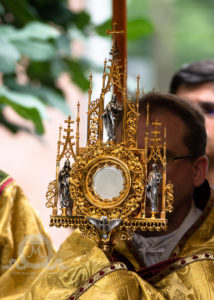
Interestingly, one of the Votive Mass options for the day of the week that Thanksgiving always occupies (Thursday) is the Mass of the Most Blessed Sacrament, the summit and center of the Church’s life. The Mass is taken from that of Corpus Christi (which is always the Thursday after Trinity Sunday), and is filled with the praise of this wonderful Sacrament, wherein Christ gives Himself as our heavenly Bread. On a holiday which is marked so distinctly by an earthly feast, it seems apt to recall first and foremost – and to give thanks for – the infinitely superior spiritual feast which He bestows on our souls not once a year, but every single day. +
The eyes of all hope in Thee, O Lord, and Thou givest them meat in due season. Thou openest Thy hand, and fillest every living creature with blessing.
– Psalm 144:15-16, the Gradual for Corpus Christi and the Votive Mass of the Blessed Sacrament
November 28, 2019

No Greater Love
“Is your father wearing his uniform?” the girl asked.
“He’s on deployment,” the boy responded. “He’s on a ship.”
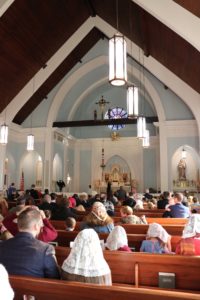
The two children, along with many others, were waiting in line outside St. Benedict’s Parish, the FSSP’s apostolate in Chesapeake, Virginia, the afternoon of Sunday, November 10th, 2019. They had just attended the parish’s annual Veterans Day Mass and were waiting to partake of the refreshments available afterwards in the parish hall. The question and the answer – and the apparent absence of the boy’s father – encapsulated in a few words the sacrifices made by those who serve, and the families who sacrifice alongside them. Many daddies were there that day in their uniforms, but at least one was not, and his son was just one of many sons and daughters, husbands and wives, fathers and mothers who daily wait and pray for the safe return of their loved ones.
St. Benedict’s began the Veterans Day Mass several years ago as a way to honor the veterans and servicemembers who are found in such large numbers in that area of Virginia and at St. Benedict’s in particular. The concentration is due to the proximity of many military bases, including the largest Naval base in the world, Naval Station Norfolk, and Joint Base Langley-Eustis, an Air Force and Army base a little further north. All in all, every military branch as well as NASA is represented in the area.
This is the 9th time the Chesapeake parish has observed this tradition, but the roots of it go back to Benedictine Preparatory School, an all-boys military high school in Richmond and the alma mater of pastor Fr. Neal Nichols, himself the son of a veteran. He and his fellow cadets, he recalls, would participate in a military Mass each First Friday, and he decided to bring the tradition to St. Benedict’s, inviting the current cadets from his former school to participate.

“It was just a big hit immediately, right away with the parishioners,” explained Fr. Nichols. The Richmond native performed his own piece of military service in 2003, when he served on a contractual basis for the 181st Support Battalion of the Washington State Army National Guard during their two-week summer training exercise. In the simulated battlefield environment he said Mass in camouflage tents or on the tailgate of a Humvee, with camouflage vestments, and offered confessions and support to the many soldiers comprising the multiple units involved in the exercise.
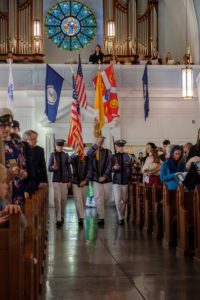
Back in Chesapeake, servicemembers are invited to attend the Veterans Day Mass in uniform, with the frontmost pews being reserved for the grey-clad Benedictine cadets, who are responsible for adding the military ceremonies to the Mass. They presented the colors before the processional, with one cadet bearing the flag of the United States and another the flag of the Vatican, each flanked by another carrying a ceremonial rifle. They placed the Stars and Stripes near the statue of Our Lady on the left (see the picture of 2018’s Mass in your 2020 Fraternity calendar) and the Vatican flag near the altar of St. Joseph on the right. Soon after, Mass began.
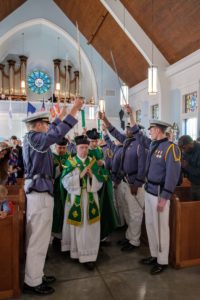
The celebrant was assistant pastor and Army veteran Fr. Anthony Forte, with Deacon Paul Minner and Fr. Nichols assisting as deacon and subdeacon. As they processed in, they first passed under a stately row of flags affixed to the front of the choir loft: a trio of colors representing the United States, the state of Virginia and St. Benedict’s Parish took the center spot, with the flags of each branch of the armed forces and the POW memorial flag accompanying them on either side. Proceeding down the aisle, the ministers and altar servers were greeted by a majestic saber arch provided by the cadets, who stood in two rows on either side, holding their swords aloft. After Mass, the arch was repeated as the ministers exited and several verses of America the Beautiful were sung by choir and congregation.

Servicemembers of various stripes then gathered before the church. One could spot the dark blue uniforms and bright white covers of several Navy officers, the classic star-edged flap collar of a sailor, the royal blue of an Air Force Master Sergeant, and even the khaki attire of a number of French NATO officers (the parish welcomes a consistent stream of French families that attend St. Benedict while they are stationed at the NATO installation in Norfolk). The sacred ministers stood in the midst, cadets to their right, military to their left. All smiled in the warm, coastal sun as the cameras captured another year of this beautiful tradition.
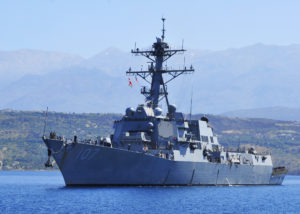
The parish deliberately joins the Mass to one of their regularly-scheduled Family Fun Days in order to give the cadets a chance to refuel before they depart for Richmond. As a bit of an extra thank-you to the young men who give up their Sunday to come and serve at the Mass, the parish always secures for them a tour of one of the commissioned military vessels at harbor in Norfolk. This year it was the USS Gravely, a guided-missile destroyer. The hoped-for object of the tour was an aircraft carrier, but since there wasn’t one available for tours that day, the destroyer had to do. It’s unlikely that anyone was disappointed; the cadets would probably tell you that a tour of an active military ship of any sort is certainly fair recompense for their trouble.
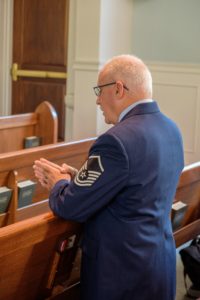
Offering fair recompense to a military member for his or her life of service, on the other hand, always seems like a more complicated proposition. You might say “thank you,” and a common response – especially among those who have shown uncommon valor – might be, “I’m just doing my job.” But they didn’t have to choose such a job, one that entails long separations from their families, holidays away from home and the possibility of danger or even death, and those of us who benefit from their sacrifice may find that “thank you,” or anything we could give them in return, just doesn’t seem enough. After all, what can you give a man in exchange for his life?
But we’ve been here before, it seems. Nothing we can give could ever constitute a fair recompense for the greatest Sacrifice, the one that the most valorous of men made for all of us upon the Cross. He knew that we could never adequately thank Him or the Father Who sent Him, so He gave us a way to do it. He gave us the Holy Sacrifice of the Mass, at the center of which is the Eucharist, a word which means thanksgiving. And so offering the greatest Sacrifice, the greatest act of thanksgiving, on behalf of our military personnel is by far the best and most fitting thing we can do.
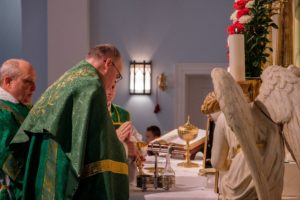
The Veterans Day Mass at St. Benedict’s furthermore proffers the idea that the sacrifices for which we thank our servicemembers are a reflection of, and a participation in, this one Sacrifice. Self-sacrifice is that thing that makes us uniquely Christ-like, Who said on the eve of His Passion that laying down one’s life for one’s friends is the highest proof of love (John 15:13). He said it, moreover, on the same night He instituted the Holy Eucharist, and directly after His True Vine discourse, wherein He speaks of the unity of Himself and His members and instructs us to abide in His love. It is, in essence, Christ Himself we are aspiring to and uniting ourselves to when we give selflessly, when we love as He did. “…having loved His own who were in the world, He loved them to the end” (John 13:1).

The mysterious union between Sacrifice and sacrifice became evident during the Consecration, when, as the Sacred Host was elevated, the cadets held a sword salute and the mournful notes of Taps drifted softly through the church. The universally-known melody, heard at every military funeral, calls us whenever we hear it to pause and reflect on the sacrifice of those who have given everything that a human can give. That day the solemn music commemorated the One Who gave every last drop of Blood, the perfect Sacrifice that our King and Captain offered once for us all and which was at that moment being offered again on the altar. It’s a Sacrifice that reverberates in the actions of everyone who, by means of his own blood or simply by the daily sacrifices that accompany military service, lays down his life for his friends. +
We thank Marine veteran Shalone Cason for his service and for all photos used in this article, except those otherwise credited.
November 25, 2019

FSSP Apostolates Appear in Our Sunday Visitor
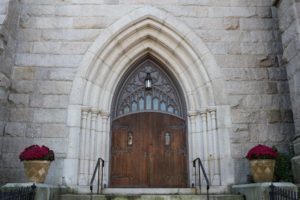
Last week, an interesting article appeared in Our Sunday Visitor written by a Catholic who regularly attends the English Mass, but had the chance to attend the Latin Mass at St. Mary Parish, our apostolate in Providence, RI. His retelling of the experience includes his impressions of the Mass, the magnificent church and the FSSP community he found there, stats from other apostolates, and thoughts from a St. Mary’s parishioner and an FSSP priest.
The first impression I had in attending the sung High Mass at 10 a.m. was the elaborate ceremony, how the priest-celebrant’s every movement at the altar seemed to be imbued with symbolism rooted in the Trinity. – from the article
Click below to read the full story!
https://www.osvnews.com/2019/11/13/experiencing-the-beauty-of-the-latin-mass-firsthand/
November 21, 2019

A Note of Thanks from FSSP Guadalajara
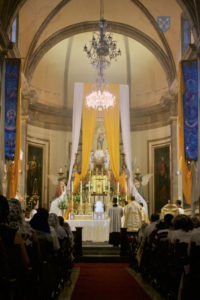
In July of this year, we informed you of the repairs needed at our parish in Guadalajara following serious damage inflicted by some vicious storms. You responded generously, and a note of thanks from pastor Fr. Daniel Heenan arrived recently along with some updates on the project.
Thank you for your support.
On behalf of our entire parish, San Pedro en Cadenas, in Guadalajara, Jalisco, I would like to thank all those who have supported generously our church restoration project. As we explained when we reached out for help, the beautiful church of Our Lady of the Pillar is an historic church in the center of Guadalajara that has many needs. We are privileged to be able to use it, but as any pastor of an old church will tell you, keeping up with the maintenance costs can be quite difficult.
I wanted to write the letter of gratitude and also to give a word of explanation about the slowness of the project. Mexico is notorious for bureaucracy and church repairs are no exception. Beginning under Benito Juárez in the middle of the 19th century and culminating under Plutarco Elias Calles in the 1920s during the Cristero period, the Mexican government confiscated all religious buildings. To this day all churches (except those built after 1992) are technically “National Patrimony.” Unfortunately this does not mean that the government takes care of the churches. It does mean that we have to obtain special permissions before doing any work. We are still in the application for the permissions to begin doing the work. One virtue an American working in Mexico certainly has to learn is patience.
We are working diligently to move this project ahead and we will continue to update you by means of the Missive when the work gets underway.
May God bless you.
Fr. Daniel Heenan, FSSP
And update you we will. Stay tuned here at the Missive for the latest on the restoration project, and again, thank you and may God reward your generosity! +
November 19, 2019

Fr. William Rock Ordained at FSSP Providence
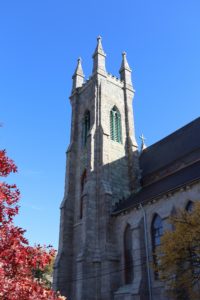
It was a fine day for an ordination. The morning of Saturday, October 26th, was cool and clear in Providence, Rhode Island, and the early sun illuminated the stone belfry of the church of St. Mary, our apostolate in Rhode Island’s capital city, just like a postcard. Inside, the crowds had already begun to gather an hour ahead of time as final preparations were made for the priestly ordination of Fr. William Rock, the FSSP’s newest priest.
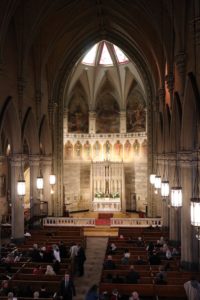
Hosting an ordination at one of our own parishes is an unusual occurrence and a great privilege, and St. Mary’s provided the perfect setting for such an occasion. Completed in 1869 and consecrated in 1901, the stunning granite structure features soaring Gothic-style arches and beautiful stained glass windows. The parish put in a great deal of work lately restoring the sanctuary, which involved removing the carpet, cleaning the underlying floor, and painting parts of it to match the red marble inlays of the newly-installed altar rail that was retrieved from a closing church in Boston and given a new lease on life at the Providence parish. What made the setting especially suitable for this particular ordination was not only the majesty of the church, but also the fact that Fr. Rock has been resident at St. Mary’s for the past year, assisting pastor Fr. John Berg with various parish duties, and he continues on as assistant pastor now that the Sacred Oil is on his hands. So one can imagine that this day held a special meaning for the parishioners of St. Mary’s, who have worked alongside Fr. Rock and Fr. Berg to build up the year-old apostolate and to prepare for this day’s events.
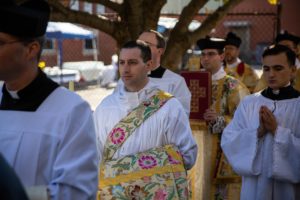
His Excellency the Most Reverend Athanasius Schneider, Auxiliary Bishop of Astana, Kazakhstan, presided over the ordination of Fr. Rock, who becomes the 6th priest ordained for FSSP North America this year after four were ordained in Nebraska and one in Canada this past May. It was a joy for the Fraternity to once again welcome Bishop Schneider, who ordained seven of our deacons in 2014 at St. Cecilia Cathedral in Omaha. Assisting at the Mass were Fr. John Killackey as deacon, Fr. Matthew Vierno as subdeacon and Superior General Fr. Andrzej Komorowski as assistant priest, with North American Superior Fr. Michael Stinson and FSSP founder and seminary Rector, the Very Rev. Fr. Josef Bisig, also assisting.

The queue was long for first blessings after Mass, the newly-consecrated Fr. Rock working through the lines tirelessly after the three-hour ordination ceremony and the faithful waiting patiently for their turn to receive the special blessing, which a priest can give for a year following his ordination and can only be received once from each priest. Outside, others waited to greet Bishop Schneider, who generously received the many who wished to meet him at a table set up in the midst of the reception that took place in the parking lot of St. Mary’s. The weather continued to be sunny and pleasant, an ideal autumn day, as the crowds partook of the many tasty offerings ranging from barbecue sandwiches, to cider, coffee and wine, to a cake emblazoned with the FSSP shield.
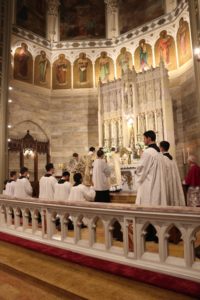
The next day, Sunday, October 27th, Bishop Schneider celebrated the 8 a.m. Low Mass, which was followed by Exposition and Benediction of the Blessed Sacrament. At 10 a.m., Fr. Rock celebrated his first Mass, a Solemn High at which he was assisted by Fr. Martin Rangel-Garcia, assistant at FSSP Mexico City, Fr. Aaron Liebert, assistant at FSSP Nashua and Fr. Benoît Guichard of Our Lady of Guadalupe Seminary. Fr. Rock again offered first blessings to the faithful after Mass, and the weekend’s festivities were capped with an informal coffee reception at which the attendees made an attempt to chow through the copious victuals left over from the previous day.
When Fr. Rock finally made it to the reception, he was greeted with applause and expressed his gratitude to all those who supported him during his years of seminary. We join him in thanking you for your spiritual and financial support of our priests and seminarians. As we look back on a year that, Fraternity-wide, saw 12 new priests ordained in four ordination ceremonies in three different countries, we can’t help but be overwhelmed by the immeasurable generosity of God in granting us such sustained growth. Please continue to pray for the Fraternity, that we may always be the priests described in the beautiful prayer that our new priests hear during their ordination, after the bishop vests them in the chasuble:
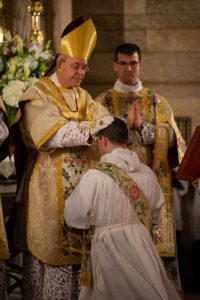
O God, the source of all holiness, of Whom are true consecration and the fullness of blessing, pour down, O Lord, on this Thy servant whom we now call to the honor of the Priesthood, the grace of Thy + blessing; that by the gravity of his actions and the example of his life, he may show himself to be an elder formed by the rule that Paul gave to Titus and Timothy; that meditating on Thy law day and night, he may believe what he reads, teach what he believes, conform to what he teaches, giving proof in himself and setting an example of justice, steadfastness, mercy, fortitude as well as all the other virtues; and by his admonition confirm others in the same, keeping the gift of his ministry pure and undefiled. May his holy blessing change for the service of Thy people bread and wine into the Body and Blood of Thy Son; and having attained through persevering charity unto mature manhood, and in old age received the fullness of Christ, may he rise again on the Day of the just and everlasting Judgment of God with a good conscience, faith unfeigned, and imbued with the Holy Ghost. +
The Rhode Island Catholic published a story yesterday on the ordination with thoughts from Fr. Rock and his family, as well as others who attended the ordination. Read it here!
All photos by Mark Garrepy, except those unattributed in the body of the article and those attributed to the Missive in the gallery.
November 16, 2019

Join FSSP Baltimore for Bishops Week
This week, November 10th through the 15th, marks FSSP Baltimore’s second annual “Bishops Week,” a week of prayer and reparation offered at the same time as the annual USCCB meeting in Baltimore. This year it began on Sunday, November 10th, with a Holy Hour, which, along with all ten public Masses offered Monday through Friday, is offered in reparation for the sins, neglects and offenses of all popes, bishops and priests, living and deceased. The conclusion will be a Solemn High Mass offered at the Shrine on Friday evening, the anniversary of the dedication of the metropolitan cathedral, which is America’s first cathedral and is located just a block away from St. Alphonsus. The anniversary is a special feast day for the diocese, and that Mass will be offered by a diocesan priest, assisted by other diocesan priests and seminarians.
Each year, you can enroll your intentions in the Week’s devotions, pledge your own reparations, or give alms for this intention. Even though the week has already started, you can still add your intentions by visiting the Shrine’s website.
FSSP Baltimore pastor Fr. Joel Kiefer began the custom of praying for the bishops during their USCCB meeting here last fall. He likes to recall that “the Church prayed without ceasing for Peter” (Acts 12:5). It is a project of the National Reparation Society, a group begun at the Shrine last year that spends a week each month (usually the first week of the month) offering Mass and devotions in reparation. A particular focus is assigned to each day: Monday is for blasphemy, Tuesday is for our nation and its leaders, Wednesday is for manhood and fatherhood, Thursday is for clergy, Friday is for sins against the Sacred Heart, Saturday is for sins against the Immaculate Heart and against life, and Sunday is for all the above. In November, the week of prayer is moved to coincide with the USCCB’s meeting. To learn more about the Reparation Society, click here. +
November 13, 2019

On the Feast of Stephen
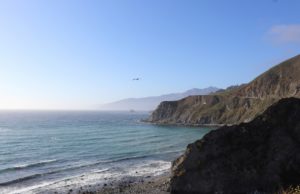
How do they do it?
It’s really the question you want to ask when you see the rather long list of things going on at St. Stephen the First Martyr Parish, our apostolate in Sacramento, California. St. Stephen’s was the final stop on the Missive’s summer California tour, and that weekend the busy parish was holding its biggest event of the year – the annual Pig Roast in honor of its patron saint.
One of the older parishes in the Fraternity, St. Stephen’s was founded in 1997 and worked out of the parishes of St. Rose and Immaculate Conception before purchasing its own church in 2002. The church was a former Lutheran building that required almost $2 million in initial renovations.
Even though it was smaller back then, the community was nonetheless very strong, said Fr. Joshua Curtis, who was appointed pastor of St. Stephen’s last year. They paid off the building in just a few years, and several sequential pastors built up the parish a step at a time. Fr. Lyons, who served as assistant for several years and then four more as pastor, brought them to the point they are at now, doing a tremendous amount of work on such projects as the parish hall and kitchen.
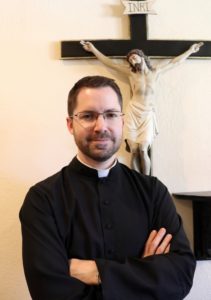
“Just rock solid,” said Fr. Curtis, describing the spirit of the former pastor, “and inexhaustible.” He would be up at 5 a.m., with the light on in his office till 9 p.m. “Day in, day out, absolutely steady.”
Fr. Lyons clearly left a huge legacy when he was appointed pastor of FSSP San Diego last summer, taking the place of Fr. Carl Gismondi who was assigned to head up our new parish in Philadelphia. But none was better equipped to take up the mantle than Fr. Curtis, who had already served for two years at St. Stephen’s as assistant pastor. And he had plenty of work before him, especially in regard to the pressing matter of their all-too-small church.

With an attendance of about 900 among the four Sunday Masses and a growth rate of 40-50 attendees per year, more space is badly needed, and plans are well afoot for expansion.
“It’s still just rough drafts at this point, but it’s been something we’ve been talking about for years,” Fr. Curtis explained. “Fr. Lyons and I started talking about it as soon as I got here, and started tossing around ideas, and sketching things just ourselves, brainstorming, thinking about difficulties.”
The goal is to at least double the capacity of the church. An architect is currently working on the official designs, with the central ideas being to add a narthex and expand seating into the wings and much further into the back. The parish hopes to eventually overhaul the sacristy and parish offices as well.
Despite the space issues, parish life goes on unabated. The number of educational and faith formation activities available for all ages are a testament to its particular character, which, among other epithets, could be described as, well, academic. The parish runs a high school co-op in which the priests teach the religion courses, including a one-year Old Testament course taught by assistant pastor Fr. Dominic Savoie and a one-year New Testament course taught by Fr. Curtis. Fr. Savoie teaches a course on faith and morality in which he goes through St. Thomas Aquinas’ Summa Theologiae in summary format, as well as popular adult formation classes, which have covered such works as the Book of Job, the Book of Genesis and the Office of the Dead. Fr. Savoie is a gifted teacher and possesses an in-depth familiarity with the Scriptures and the Church Fathers: if you read our Meménto newsletter, you have benefited from his vast supply of knowledge in our Ask Father column.
Fr. Curtis spoke with enthusiasm about the upcoming catechumenate program, a series of classes for those interested in coming into the Church. Up to this point, candidates for Baptism have met with a priest one-on-one for formation, but Fr. Curtis wanted to start something that was also accessible to parishioners and even people from other parishes who wished to deepen their knowledge of the Faith. Fr. Curtis further noted that one-on-one classes do not help the candidate plug into the life of the parish. According to the new plan, candidates will attend group classes twice a month and have a chance to meet each other and other parishioners, have refreshments and socialize for part of the time. Hence when it comes time for them to be baptized, they will already be well-integrated into the parish. Additionally, St. Stephen’s has permission to celebrate the pre-1955 Holy Week liturgy, which entails an earlier start time for the Easter Vigil and is more conducive to public baptisms than the later version. The candidates will therefore be baptized at the Vigil and welcomed into the Church and the parish in a public way.

If we enumerated everything that’s going on at this lively hub of Fraternity life, this article would be reams long, so we’ll just touch on a few more activities. St. Stephen’s keeps up a number of charitable works, including participating in the Brown Bag Lunch program, an operation run out of the Sacramento Cathedral that involves giving out bagged lunches to the homeless of the area. St. Stephen’s is one of the parishes that provide the Cathedral with hundreds of bagged lunches, parishioners donating the food, putting together the lunches and transporting them to the Cathedral. A newly-founded chapter of the St. Vincent de Paul Society also assists the needy, processing and responding to requests for help that come to St. Stephen’s and giving the parish a reliable arm with which to handle these cases.
Now, we would be remiss if we didn’t mention the St. Stephen’s Bookstore, a place filled not only with a wide selection of Catholic reading material, sacramentals, medals and other gifts, but also with the joyful energy that seems to be a St. Stephen’s trademark. It’s a focal point for life at the parish, and though it really requires an article unto itself and we can’t do more than mention it here, we’ll be posting about it later on so stay tuned.
Of course, the whole reason we chose that weekend to visit St. Stephen’s was the annual Pig Roast, which is a part of the celebration of the feast day of their patron, St. Stephen the First Martyr. At this point you may be asking why they celebrate their patron on a date so distant from his liturgical feast day (if you don’t remember when that is, the words to a famous song will give you an idea: Good King Wenceslaus looked out, on the feast of Stephen, when the snow lay round about, deep and crisp and even…). Yes, it’s December 26th, not the best time for a parish party. When this happens, sometimes parishes can get permission to celebrate their patronal feast day at another time. Conveniently for St. Stephen’s, an old feast of his exists in August – the feast of the finding of his relics, which falls on August 3rd. They therefore celebrate their holy patron near that time.
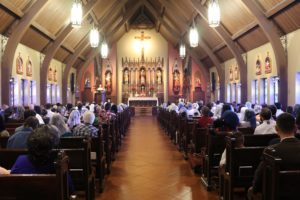
The big day this year was Sunday, August 4th, and the High Mass, usually at 10:30 a.m., was moved to the 1:30 p.m. time slot so as to sync with the rest of the day’s events. The Mass was that of the External Solemnity of St. Stephen, and the crowds filled the church. At 3:30 p.m., Vespers were sung and at 5 p.m., dinner began. Families and friends lined up to partake of the smorgasbord set up inside the parish hall, a spacious, high-ceilinged building, once a gym, that provides abundant space for parish events. The fare included, yes, you guessed it, roast pig, along with a variety of other treats including hamburgers, chili, mac & cheese, salad and watermelon.
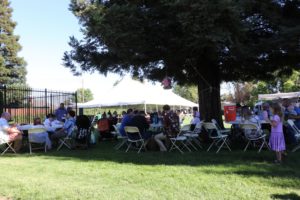
The partygoers bore their plates of victuals outside and gathered at tables under the boughs of trees or in the shade of a great tent set up on the grassy expanse that lies beyond the main parish complex, trayfuls of ice cream making their way around the crowds as dinner was concluding. The children enjoyed face-painting, a magic show, sno cones, taking swings at piñatas hung from one of the trees and, of course, dogpiling on the candy that eventually rained down. The tables were moved out from under the tent after dinner and square dancing, complete with a live band, took their place.
So, if you find yourself in northern California around the beginning of August, we highly recommend joining St. Stephen’s for their yearly festivities. But as you can tell, there really isn’t a bad time to visit. All year round it is a glowing example of that comprehensive parish life that the Fraternity strives to provide as an important complement to the Holy Mass and the Sacraments. Friendships, education, faith formation, charitable work, evangelization and recreation are all critical components to a well-balanced Catholic life, and the parish in California’s capital city does it all. +
November 8, 2019

Major News Outlets Carry News of FSSP’s Growth
The internet is abuzz with the recent news of the extraordinary growth of the FSSP over the past year. Our article was published on October 17th, 2019, and since then the great news of the Fraternity’s growth has been carried by several major news outlets:
– 11/2 – The Washington Examiner published their own analysis, which includes a link to and information from our article;
– 11/3 – EWTN News retweeted the Examiner article to nearly 20,000 followers;
– 11/4 – The Catholic Herald included the Examiner article on its list of “Morning Catholic Must-Reads”;
– 11/4 – Patheos reposted portions of our article and the Examiner article in a summary report.
Please continue to share, repost and otherwise spread this wonderful news about the FSSP’s work! Thank you for your support of the FSSP and may God reward you! +
November 6, 2019


